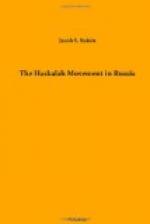But most unfounded of all was the allegation that Jews were opposed to education. The Memoirs of Madame Pauline Wengeroff indicate that even among the very strict Jews of her time children were not denied instruction in the German, Polish, and Russian literatures. We have seen how they availed themselves of the permission, granted to them by Alexander I, to attend the schools and universities of the empire. Nor did they fail to open schools of their own. No sooner was the Franco-Russian war over than Joseph Perl of Galicia founded a school in Tarnopol (1813), then under the Russian Government, and two years later he drew upon his own resources to build a school-house large enough to accommodate the great, steadily growing number of students. In 1822 we hear of a school that had been in existence for some time in Uman (the Ukraine). It had been established by Meir Horn, Moses Landau, and Hirsh Hurwitz, all of whom were indefatigable laborers in the cause of Haskalah in the Ukraine. Perl’s school was the pattern and model for a multitude of other schools, among them the one founded by Zittenfeld (1826) in Odessa, in the faculty of which were Simhah Pinsker, Elijah Finkel, the grandson of Elijah Gaon, and Abraham Abele, the eminent Talmudist. In 1836 a girls’ department was added to it, and when Lilienthal visited Odessa (ab. 1843) it had an attendance of from four to five hundred pupils of both sexes, the annual expense being twenty-eight thousand rubles. A similar school was opened in Kishinev by Stern, and in the early “forties” there was hardly a Jewish community of note without one or more of such Jewish public institutions. Several well-to-do Maskilim not only founded but, like Perl, also maintained such schools, and gave instruction in some or all of the subjects taught in them.[3]
The “forties” began auspiciously for Haskalah in Russia. On January 15, 1840, the Riga community, amid pomp and rejoicing, opened the first Jewish school affiliated with a university. The teaching staff consisted of three Jews and one Christian, with Doctor Max Lilienthal (1815-1882), the young, highly recommended, and recently chosen local rabbi, as its principal. In the same year, the indefatigable Basilius Stern succeeded in forming a committee, of which Hayyim Efrusi and Moses Lichtenstadt were members, to deliberate on founding rabbinical seminaries in Russia. In 1841, forty-five delegates, representing the six chief committees of the Lovers of Enlightenment, assembled in Vilna, and thence issued an appeal in which they adopted as their platform the elevation of the moral standards of adults by urging them to follow useful trades and discouraging the Jewish proclivity to business as much as possible; a reform of the prevailing system of the education of the young; the combating, if possible the eradication, of Hasidism, the fountainhead, as they thought, of ignorance and superstition; the establishment of rabbinical seminaries, after the model of those




